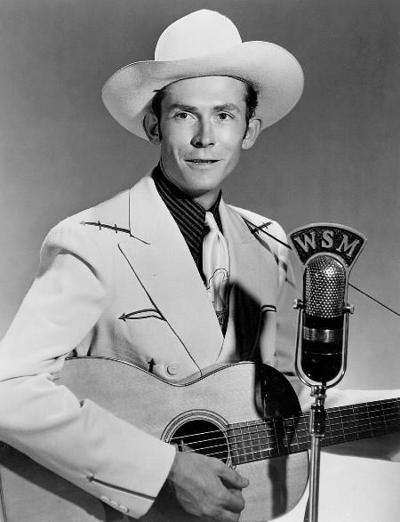One of my all-time favorite musical artists died long before I was old enough to play his recordings for myself.
The reason I’ve been thinking about him and his music over the past week is because I’d watched a new, brief, half-hour documentary, “The Day the Rock Start Died: Hank Williams.”
Hank, of course, was a country music singer, not a rock star — although he certainly lived like one at times.
While the music historians and critics shown in the documentary recognized Williams’ artistry, a statement by one of them seemed incredulous to me. I’d heard this theory before — and didn’t believe it then either!
Since Hank Williams died at the untimely age of 29 on the first day of 1953, he passed away about a year before rock ‘n’ roll music began rising in popularity.
One of the critics on the “the Day the Rock Star” died said that had Hank lived to see the rise of rock ‘n’ roll, he would have felt threatened by it.
That’s far from the way I see it. Hank, along with Bob Wills and His Texas Playboys, were two of the first country music artists to make the “beat” a vital part of their records. Wills did it by having a drummer in his band — but Williams added the drum-like beat heard on his records by the act of “damping” a guitar — hitting the palm against the guitar strings to mute them and give the instrument a drum-like sound.
It was Williams’ way to get around the unwritten dictum at the time that there would be no drums in country music. (Wills got around it by playing Western swing — which has about as much in common with jazz as is does with country music.)
I don’t think Hank would have felt threatened by rock ‘n’ roll music at all. Not that he would have become a convert, but I think he’d embrace what he liked about it — not the least of which would be its driving beat.
It all got me to thinking about how I first learned about Hank Williams as a kid thumbing through my parents’ album collection while growing up in Southeastern Oklahoma.
My parents were country music fans and I grew up hearing albums by fantastic artists such as Johnny Cash and Marty Robbins, but I never heard of this Hank Williams guy until I came across the album “George Jones Salutes Hank Williams” — an album filled with some of the best songs I’d ever heard.
When I scanned the record label to see who’d written all those great songs, I found that Hank himself had written all but two of the numbers on Jones’ 12-track album.
I may have been a kid, I knew a musical and lyrical genius when I heard one. Here was a guy who could jump from the heartbreak evident on songs such as “Cold, Cold Heart” and “I Can’t Help It (If I’m Still in Love With You)” to the humor of “Howlin’ at the Moon” and “Hey Good Lookin’.”
Still, I didn’t get to actually hear Hank Williams sing on the George Jones salute. As great as Jones sounded when singing those songs, I longed to hear the voice of that Hank Williams fellow and tried to imagine what he sounded like. Since country music radio at the time played everyone from Ray Price to Bobby Bare, the possibilities were limitless.
Although the local AM radio station KNED played all kinds of country music, I don’t remember hearing anything by Hank. He’d died on the first day of 1953, so no new songs of his were being issued by the time I discovered his music. Country music radio at the time concentrated on the then-current country hits by artists such as Buck Owens and the Buckaroos.
Although it seems hard to believe now, no Hank Williams albums were available in the local record shops, either.
However, Hank had certainly caught my attention in a big way. My parents owned a number of early Johnny Cash albums. While Cash also was a great songwriter, he once issued an album featuring his interpretations of songs by some of his fellow country music artists. He named the album “Now There Was a Song!”
As I scanned the songwriting credits on that album, I stopped at the tenth track. This Hank Williams guy had written one of my favorite songs on the album, too. “I’m So Lonesome I Could Cry” contained lyrics that weren’t your normal country music fare at the time, or, for that matter, not your normal popular music, rhythm and blues and or rock ‘n’ roll music fare of the time, either.
Lyrics such as “The silence of a falling star lights up a purple sky” and “Did you ever see a robin weep when leaves begin to die” reached lyrical heights I’d never previously heard. Now, in addition to the 10 tracks he’d written on the George Jones album, I’d discovered another great song he created. Who was this guy?
One day while walking in front of the Liberty Theater in downtown Hartshorne, I saw a large poster proclaiming coming attractions. Lo and behold! The poster showed that in couple of weeks a movie about the life of Hank Williams named “Your Cheatin’ Heart” would be playing!
“The immortal Hank Williams lives again, sings again,” the poster proclaimed. In addition, the poster cited the title of more of Hank’s songs I’d never heard at the time, but would stay with me for life, — such as “I Saw the Light,” and “Long Gone Lonesome Blues.”
Of course I saw the movie — twice. I thought Hollywood actor George Hamilton did a credible job portraying a country singer, staying away from the hokey, over-the-top southern accent so many Hollywood actors used. I later learned that Hamilton was born in Memphis and also lived in Arkansas in his younger years. All he had to do was act naturally.
Alas though, I also learned that Hank’s son, the then- eenaged Hank Williams Jr., sang the songs on the movie soundtrack. Hamilton had badly wanted to sing them himself, but studio executives insisted he lip synch to Hank Jr.’s recordings.
I began to wonder if I’d ever get to hear hear Hank Sr. sing — until one day, flipping through a row of albums in Henley’s Rexall Drug Store, I made an amazing find. Could it be? It was! A bonafide Hank Williams album titled “I’m Blue Inside.” I scrapped together the $3.97 need to buy it (Please, mom), rushed home, listened to it — and have been listening ever since.
A little over a year after Hank died, Bill Haley and His Comets would record “Rock Around the Clock” — with the 1954 recording considered by many to be one of the first rock ‘n’ roll hits. That same year, Elvis Presley walked into the Sun Records studio in Memphis and recorded his first hit song, “That’s All Right (Mama). Chuck Berry would not record his first hit, “Maybellene,” until 1955.
Then go back and listen to Hank’s self-penned hit, “Move It On Over” — recorded in 1947.
Hank threatened by rock ‘n’ roll? Never! He played it before it had a name.
Contact James Beaty at jbeaty@mcalesternews.com




















Commented
Sorry, there are no recent results for popular commented articles.